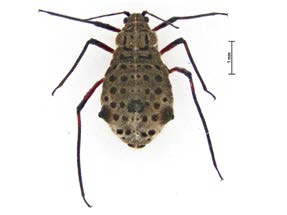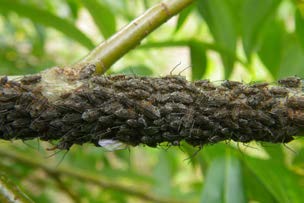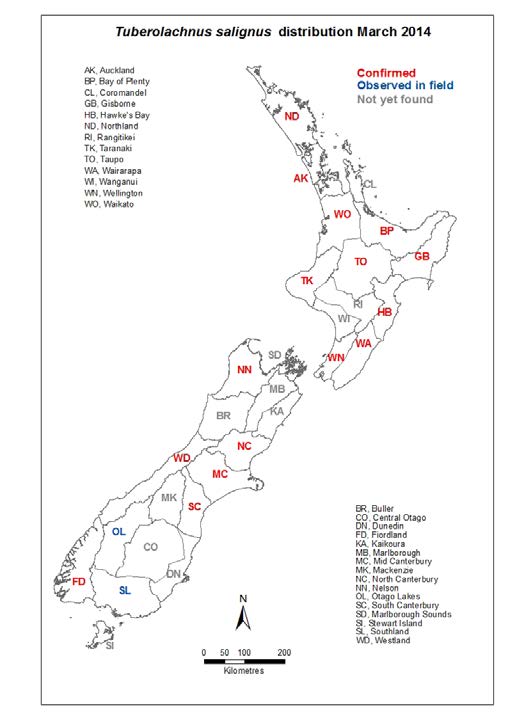PESTS AND DISEASES OF FORESTRY IN NEW ZEALAND
Tuberolachnus salignus, a new aphid on the block
Scion is the leading provider of forest-related knowledge in New Zealand
Formerly known as the Forest Research Institute, Scion has been a leader in research relating to forest health for over 50 years. The Rotorua-based Crown Research Institute continues to provide science that will protect all forests from damage caused by insect pests, pathogens and weeds. The information presented below arises from these research activities.
From Forest Health News 246, March 2014.

The giant willow aphid, Tuberolachnus salignus (Hemiptera: Aphididae) was first found in New Zealand on 23 Dec 2013 at Western Springs Park, Auckland by entomologist Stephen Thorpe. Surprisingly, subsequent surveys have revealed that it is already well established throughout much of New Zealand (see map).
Tuberolachnus salignus is virtually cosmopolitan and is highly conspicuous. It is one of the largest known aphids (up to 6 mm in body length) and is patterned with spots and sports a “shark’s fin” tubercle on the dorsum (see photo). It feeds on sap from the young stems and branches of its host trees, which include species of Salix (willow) and occasionally, Populus (poplar).
Large dense colonies of the giant willow aphid form over summer. Reproduction occurs asexually with no males having ever been found, thus the aphids in these colonies are typically clones. The aphids are noted to be long lived, with winged individuals in particular displaying lengthy maternal care of their offspring. In Great Britain colonies are apparent from mid-summer into late winter, after which the aphids curiously disappear in spring. We may expect to see a similar trend in New Zealand with T. salignus present between December and July.

The degree of injury to the host plants is not well documented, however an overseas study on potted and hydroponic cuttings of willow reported that giant willow aphid caused drastic growth reductions during and subsequent to infestation, and also altered the mass of previously developed woody tissue. In New Zealand the extent of the damage remains to be seen, but this pest could pose problems where willows are used for flood protection and in shelterbelts.
Thus far in New Zealand the aphid has been reported from Salix alba var. vitellina, S. babylonica, S. caprea, S. cinerea, S. fragilis, S. humboldtiana, S. matsudana, S. viminalis, S. x sepulcralis and Populus nigra.
No parasitoids have been observed in New Zealand, however possible predators include ladybirds which have been found in association with colonies of T. salignus: Adalia bipunctata and possibly Halmus chalybeus though the latter is known primarily as a scale predator and may have been more attracted to honeydew residues produced by the aphid. Interestingly, entire colonies of the aphids elsewhere have been observed waving their hind legs in the air in response to the presence of predators.
Other insects associated with T. salignus include various honeydew feeders. There are reports of significant Vespula spp. wasp activity around honeydew deposits at some infestation sites in New Zealand. This has caused secondary problems in amenity areas where people have been stung. Colonies are sometimes associated with ants tending the aphids for honeydew, and when ants are not present masses of honeydew tend to collect on nearby surfaces attracting pest insects such as wasps.
Concerns have also been raised within the horticultural industry after the aphids were observed to be present on the surface of kiwifruit. Although kiwifruit is not a host, sooty mould associated with honeydew could affect export markets.
Although it is not known exactly where T. salignus hails from, a foe has given us a clue. Reports of parasitism (by the braconid wasp Pauesia salignae) come only from Japan, Korea and Taiwan, suggesting this region as a likely place of origin. Prior to the New Zealand find, T. salignus was notably absent from Australasia, although in early March 2014 it was detected in Tasmania on willows near Launceston and Devonport. To date there are no records from the Australian mainland. Given that so many of our insect imports originate from Australia it is likely that the aphid reached New Zealand via Australia.

Stephanie Sopow & Belinda Gresham; Disna Gunawardana & Alan Flynn (Ministry for Primary Industries)
This information is intended for general interest only. It is not intended to be a substitute for specific specialist advice on any matter and should not be relied on for that purpose. Scion will not be liable for any direct, indirect, incidental, special, consequential or exemplary damages, loss of profits, or any other intangible losses that result from using the information provided on this site.
(Scion is the trading name of the New Zealand Forest Research Institute Limited.)



